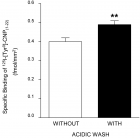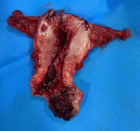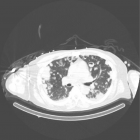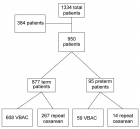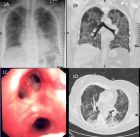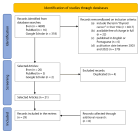Abstract
Mini Review
Advances in research of the structural gene characteristics of the aflatoxin biosynthetic gene cluster
Zhu-Mei He* and Qi-Zhang Li
Published: 31 October, 2018 | Volume 2 - Issue 3 | Pages: 068-082
Aflatoxins, produced by Aspergillus spp., are strongly toxic and carcinogenic fungal secondary metabolites. Aflatoxin biosynthesis is a complex process and involves at least 30 genes clustered within an approximately 75 kB gene cluster. In this paper, we reviewed current status of the researches on the characterized structural genes involved in aflatoxin biosynthesis and their roles in aflatoxin-producing fungi, especially in A. flavus and A. parasiticus, which will improve our understanding of the mechanism of aflatoxin biosynthesis and regulation and provide reference for further study.
Read Full Article HTML DOI: 10.29328/journal.jpsp.1001022 Cite this Article Read Full Article PDF
Keywords:
Aflatoxins; Structural genes; Aspergillus flavus; Aspergillus parasiticus; promoter
References
- Eaton DL, Gallagher EP. Mechanisms of aflatoxin carcinogenesis. Annu Rev Pharmacol Toxicol. 1994; 34: 135-172. Ref.: https://goo.gl/8JAKV7
- >Bennett JW. Mycotoxins, mycotoxicoses, mycotoxicology and Mycopathologia. Mycopathologia. 1987; 100: 3-5. Ref.: https://goo.gl/CmPAS5
- Massey TE, Stewart RK, Daniels JM, Liu L. Biochemical and molecular aspects of mammalian susceptibility to aflatoxin B1 carcinogenicity. Proc Soc Exp Biol Med. 1995; 208: 213-227. Ref.: https://goo.gl/d9y8sT
- Yu J, Chang PK, Cary JW, Wright M, Bhatnagar D, et al. Comparative mapping of aflatoxin pathway gene clusters in Aspergillus parasiticus and Aspergillus flavus. Appl Environ Microbiol. 1995; 61: 2365-2371. Ref.: https://goo.gl/QAQBW8
- Yu J. Current understanding on aflatoxin biosynthesis and future perspective in reducing aflatoxin contamination. Toxins (Basel). 2012; 4: 1024-1057. Ref.: https://goo.gl/CZ694W
- Ehrlich KC, Yu J, Cotty PJ. Aflatoxin biosynthesis gene clusters and flanking regions. J Appl Microbiol. 2005; 99: 518-527. Ref.: https://goo.gl/LQLFdo
- Yu J, Chang PK, Ehrlich KC, Cary JW, Bhatnagar D, et al. Clustered pathway genes in aflatoxin biosynthesis. Appl Environ Microbiol. 2004; 70: 1253-1262. Ref.: https://goo.gl/zbda36
- Yabe K, Nakajima H. Enzyme reactions and genes in aflatoxin biosynthesis. Appl Microbiol Biotechnol. 2004; 64: 745-755. Ref.: https://goo.gl/zPC4Sf
- Bhatnagar D, Ehrlich KC, Cleveland TE. Molecular genetic analysis and regulation of aflatoxin biosynthesis. Appl Microbiol Biotechnol. 2003; 61: 83-93. https://goo.gl/L5eeWW
- Yabe K, Ando Y, Hamasaki T. Biosynthetic relationship among aflatoxins B1, B2, G1, and G2. Appl Environ Microbiol. 1988; 54: 2101-2106. Ref.: https://goo.gl/PLn7Uw
- Trucksess MW, Mislivec PB, Young K, Bruce VR, Page SW. Cyclopiazonic acid production by cultures of Aspergillus and Penicillium species isolated from dried beans, corn meal, macaroni, and pecans. J Assoc Off Anal Chem. 1987; 70: 123-126. Ref.: https://goo.gl/LbmR4V
- Rosfarizan M, Ariff AB, Hassan MA, Karim MI. Kojic acid production by Aspergillus flavus using gelatinized and hydrolyzed sago starch as carbon sources. Folia Microbiol (Praha). 1998; 43: 459-464. Ref.: https://goo.gl/TfxyP6
- Ehrlich KC. Predicted roles of the uncharacterized clustered genes in aflatoxin biosynthesis. Toxins (Basel). 2009; 1: 37-58. Ref.: https://goo.gl/rsMKXe
- Watanabe CM, Wilson D, Linz JE, Townsend CA. Demonstration of the catalytic roles and evidence for the physical association of type I fatty acid synthases and a polyketide synthase in the biosynthesis of aflatoxin B1. Chem Biol. 1996; 3: 463-469. Ref.: https://goo.gl/bjsyQ1
- Watanabe CM, Townsend CA. Initial characterization of a type I fatty acid synthase and polyketide synthase multienzyme complex NorS in the biosynthesis of aflatoxin B(1). Chem Biol. 2002; 9: 981-988. Ref.: https://goo.gl/q7jwaT
- Hitchman TS, Schmidt EW, Trail F, Rarick MD, Linz JE, et al. Hexanoate synthase, a specialized type I fatty acid synthase in aflatoxin B1 biosynthesis. Bioorg Chem. 2001; 29: 293-307. Ref.: https://goo.gl/YfrbLn
- Townsend CA, Christensen SB, Trautwein K. Hexanoate as a starter unit in polyketide biosynthesis. J Am Chem Soc. 1984; 106: 3868-3869. Ref.: https://goo.gl/Ua2fQB
- Mahanti N, Bhatnagar D, Cary JW, Joubran J, Linz JE. Structure and function of fas-1A, a gene encoding a putative fatty acid synthetase directly involved in aflatoxin biosynthesis in Aspergillus parasiticus. Appl Environ Microbiol. 1996; 62: 191-195. Ref.: https://goo.gl/DeXEb9
- Hong SY, Roze LV, Wee J, Linz JE. Evidence that a transcription factor regulatory network coordinates oxidative stress response and secondary metabolism in aspergilli. Microbiologyopen. 2013; 2: 144-160. Ref.: https://goo.gl/AkvVWj
- Roze LV, Miller MJ, Rarick M, Mahanti N, Linz JE. A novel cAMP-response element, CRE1, modulates expression of nor-1 in Aspergillus parasiticus. J Biol Chem. 2004; 279: 27428-27439. Ref.: https://goo.gl/BUJME6
- Roze LV, Chanda A, Wee J, Awad D, Linz JE. Stress-related transcription factor AtfB integrates secondary metabolism with oxidative stress response in aspergilli. J Biol Chem. 2011; 286: 35137-35148. Ref.: https://goo.gl/fXmhTw
- Crawford JM, Dancy BC, Hill EA, Udwary DW, Townsend CA. Identification of a starter unit acyl-carrier protein transacylase domain in an iterative type I polyketide synthase. Proc Natl Acad Sci U S A. 2006; 103: 16728-16733. Ref.: https://goo.gl/R1JscB
- Crawford JM, Korman TP, Labonte JW, Vagstad AL, Hill EA, et al. Structural basis for biosynthetic programming of fungal aromatic polyketide cyclization. Nature. 2009; 461: 1139-1143. Ref.: https://goo.gl/95sTJk
- Chang PK, Cary JW, Yu J, Bhatnagar D, Cleveland TE. The Aspergillus parasiticus polyketide synthase gene pksA, a homolog of Aspergillus nidulans wA, is required for aflatoxin B1 biosynthesis. Mol Gen Genet. 1995; 248: 270-277. Ref.: https://goo.gl/b2iYwm
- Trail F, Mahanti N, Rarick M, Mehigh R, Liang SH, et al. Physical and transcriptional map of an aflatoxin gene cluster in Aspergillus parasiticus and functional disruption of a gene involved early in the aflatoxin pathway. Appl Environ Microbiol. 1995; 61: 2665-2673. Ref.: https://goo.gl/nkPc5w
- Feng GH, Leonard TJ. Characterization of the polyketide synthase gene (pksL1) required for aflatoxin biosynthesis in Aspergillus parasiticus. J Bacteriol. 1995; 177: 6246-6254. Ref.: https://goo.gl/M4Kgf7
- Ehrlich KC, Montalbano BG, Cary JW. Binding of the C6-zinc cluster protein, AFLR, to the promoters of aflatoxin pathway biosynthesis genes in Aspergillus parasiticus. Gene. 1999; 230: 249-257. Ref.: https://goo.gl/93LpKG
- Ehrlich KC, Montalbano BG, Cary JW, Cotty PJ. Promoter elements in the aflatoxin pathway polyketide synthase gene. Biochim Biophys Acta. 2002; 1576: 171-175. Ref.: https://goo.gl/GW2XiA
- Udwary DW, Merski M, Townsend CA. A method for prediction of the locations of linker regions within large multifunctional proteins, and application to a type I polyketide synthase. J Mol Biol. 2002; 323: 585-598. Ref.: https://goo.gl/P7gSqS
- Crawford JM, Vagstad AL, Ehrlich KC, Townsend CA. Starter unit specificity directs genome mining of polyketide synthase pathways in fungi. Bioorg Chem. 2008; 36: 16-22. Ref.: https://goo.gl/e7uUnF
- Crawford JM, Thomas PM, Scheerer JR, Vagstad AL, Kelleher NL, et al. Deconstruction of iterative multidomain polyketide synthase function. Science. 2008; 320: 243-246. Ref.: https://goo.gl/XARYms
- Bennett JW, Christensen SB. New perspectives on aflatoxin biosynthesis. Adv Appl Microbiol. 1983; 29: 53-92. Ref.: https://goo.gl/LdqTXq
- Ehrlich KC, Scharfenstein LL Jr., Montalbano BG, Chang PK. Are the genes nadA and norB involved in formation of aflatoxin G(1)? Int J Mol Sci. 2008; 9: 1717-1729. Ref.: https://goo.gl/V8fJv4
- Zhou R, Linz JE. Enzymatic function of the nor-1 protein in aflatoxin biosynthesis in Aspergillus parasiticus. Appl Environ Microbiol. 1999; 65: 5639-5641. Ref.: https://goo.gl/8VYKGB
- Trail F, Chang PK, Cary J, Linz JE. Structural and functional analysis of the nor-1 gene involved in the biosynthesis of aflatoxins by Aspergillus parasiticus. Appl Environ Microbiol. 1994; 60: 4078-4085. Ref.: https://goo.gl/bvqnoQ
- Miller MJ, Roze LV, Trail F, Linz JE. Role of cis-acting sites NorL, a TATA box, and AflR1 in nor-1 transcriptional activation in Aspergillus parasiticus. Appl Environ Microbiol. 2005; 71: 1539-1545. Ref.: https://goo.gl/YwkVTu
- Yabe K, Nakamura Y, Nakajima H, Ando Y, Hamasaki T. Enzymatic conversion of norsolorinic acid to averufin in aflatoxin biosynthesis. Appl Environ Microbiol. 1991; 57: 1340-1345. Ref.: https://goo.gl/T1SZo4
- Cary JW, Wright M, Bhatnagar D, Lee R, Chu FS. Molecular characterization of an Aspergillus parasiticus dehydrogenase gene, norA, located on the aflatoxin biosynthesis gene cluster. Appl Environ Microbiol. 1996; 62: 360-366. Ref.: https://goo.gl/VA1iw1
- Yu J, Bhatnagar D, Cleveland TE. Completed sequence of aflatoxin pathway gene cluster in Aspergillus parasiticus. FEBS Lett. 2004; 564: 126-130. Ref.: https://goo.gl/MEzEze
- Ehrlich KC, Chang PK, Yu J, Cotty PJ. Aflatoxin biosynthesis cluster gene cypA is required for G aflatoxin formation. Appl Environ Microbiol. 2004; 70: 6518-6524. Ref.: https://goo.gl/Ukixmd
- Chang PK, Yu J, Ehrlich KC, Boue SM, Montalbano BG, et al. adhA in Aspergillus parasiticus is involved in conversion of 5'-hydroxyaverantin to averufin. Appl Environ Microbiol. 2000; 66: 4715-4719. Ref.: https://goo.gl/q8HbAL
- Bateman A, Birney E, Durbin R, Eddy SR, Finn RD, et al. Pfam 3.1: 1313 multiple alignments and profile HMMs match the majority of proteins. Nucleic Acids Res. 1999; 27: 260-262. Ref.: https://goo.gl/DvrSZ5
- Sakuno E, Yabe K, Nakajima H. Involvement of two cytosolic enzymes and a novel intermediate, 5'-Oxoaverantin, in the pathway from 5'-Hydroxyaverantin to averufin in aflatoxin biosynthesis. Appl Environ Microbiol. 2003; 69: 6418-6426. Ref.: https://goo.gl/uJYiWt
- Yu J, Woloshuk CP, Bhatnagar D, Cleveland TE. Cloning and characterization of avfA and omtB genes involved in aflatoxin biosynthesis in three Aspergillus species. Gene. 2000; 248: 157-167. Ref.: https://goo.gl/1LwU74
- Motomura M, Chihaya N, Shinozawa T, Hamasaki T, Yabe K. Cloning and characterization of the O-methyltransferase I gene (dmtA) from Aspergillus parasiticus associated with the conversions of demethylsterigmatocystin to sterigmatocystin and dihydrodemethylsterigmatocystin to dihydrosterigmatocystin in aflatoxin biosynthesis. Appl Environ Microbiol. 1999; 65: 4987-4994. Ref.: https://goo.gl/oSedyJ
- Yabe K, Chihaya N, Hamamatsu S, Sakuno E, Hamasaki T, et al. Enzymatic conversion of averufin to hydroxyversicolorone and elucidation of a novel metabolic grid involved in aflatoxin biosynthesis. Appl Environ Microbiol. 2003; 69: 66-73. Ref.: https://goo.gl/Zry8nN
- Yu J, Chang PK, Bhatnagar D, Cleveland TE. Genes encoding cytochrome P450 and monooxygenase enzymes define one end of the aflatoxin pathway gene cluster in Aspergillus parasiticus. Appl Microbiol Biotechnol. 2000; 53: 583-590. Ref.: https://goo.gl/cyqcvZ
- Cary JW, Ehrlich KC, Bland JM, Montalbano BG. The aflatoxin biosynthesis cluster gene, aflX, encodes an oxidoreductase involved in conversion of versicolorin A to demethylsterigmatocystin. Appl Environ Microbiol. 2006; 72: 1096-1101. Ref.: https://goo.gl/CG9Sxb
- Ehrlich KC, Montalbano B, Boue SM, Bhatnagar D. An aflatoxin biosynthesis cluster gene encodes a novel oxidase required for conversion of versicolorin a to sterigmatocystin. Appl Environ Microbiol. 2005; 71: 8963-8965. Ref.: https://goo.gl/iPggiS
- Liang SH, Skory CD, Linz JE. Characterization of the function of the ver-1A and ver-1B genes, involved in aflatoxin biosynthesis in Aspergillus parasiticus. Appl Environ Microbiol. 1996; 62: 4568-4575. Ref.: https://goo.gl/uUepJY
- Skory CD, Chang PK, Cary J, Linz JE. Isolation and characterization of a gene from Aspergillus parasiticus associated with the conversion of versicolorin A to sterigmatocystin in aflatoxin biosynthesis. Appl Environ Microbiol. 1992; 58: 3527-3537. Ref.: https://goo.gl/YVtkf2
- Hallam SE, Malpartida F, Hopwood DA. Nucleotide sequence, transcription and deduced function of a gene involved in polyketide antibiotic synthesis in Streptomyces coelicolor. Gene. 1988; 74: 305-320. Ref.: https://goo.gl/EPXthu
- Delledonne M, Porcari R, Fogher C. Nucleotide sequence of the nodG gene of Azospirillum brasilense. Nucleic Acids Res. 1990; 18: 6435. Ref.: https://goo.gl/6G4AsR
- Heilmann HJ, Magert HJ, Gassen HG. Identification and isolation of glucose dehydrogenase genes of Bacillus megaterium M1286 and their expression in Escherichia coli. Eur J Biochem. 1988; 174: 485-490. Ref.: https://goo.gl/rUd2k4
- Hopwood DA, Sherman DH. Molecular genetics of polyketides and its comparison to fatty acid biosynthesis. Annu Rev Genet. 1990; 24: 37-66. Ref.: https://goo.gl/1AwzYP
- Kamps MP, Taylor SS, Sefton BM. Direct evidence that oncogenic tyrosine kinases and cyclic AMP-dependent protein kinase have homologous ATP-binding sites. Nature. 1984; 310: 589-592. Ref.: https://goo.gl/R3KUKy
- Udwary DW, Casillas LK, Townsend CA. Synthesis of 11-hydroxyl O-methylsterigmatocystin and the role of a cytochrome P-450 in the final step of aflatoxin biosynthesis. J Am Chem Soc. 2002; 124: 5294-5303. Ref.: https://goo.gl/2ju9Au
- Price MS, Yu J, Nierman WC, Kim HS, Pritchard B, et al. The aflatoxin pathway regulator AflR induces gene transcription inside and outside of the aflatoxin biosynthetic cluster. FEMS Microbiol Lett. 2006; 255: 275-279. Ref.: https://goo.gl/kmx4hm
- Yu J, Chang PK, Cary JW, Bhatnagar D, Cleveland TE. avnA, a gene encoding a cytochrome P-450 monooxygenase, is involved in the conversion of averantin to averufin in aflatoxin biosynthesis in Aspergillus parasiticus. Appl Environ Microbiol. 1997; 63: 1349-1356. Ref.: https://goo.gl/4emi7c
- Cary JW, Montalbano BG, Ehrlich KC. Promoter elements involved in the expression of the Aspergillus parasiticus aflatoxin biosynthesis pathway gene avnA. Biochim Biophys Acta. 2000; 1491: 7-12. Ref.: https://goo.gl/oapVdn
- Keller NP, Watanabe CM, Kelkar HS, Adams TH, Townsend CA. Requirement of monooxygenase-mediated steps for sterigmatocystin biosynthesis by Aspergillus nidulans. Appl Environ Microbiol. 2000; 66: 359-362. Ref.: https://goo.gl/iwAA8S
- Yabe K, Hamasaki T. Stereochemistry during aflatoxin biosynthesis: cyclase reaction in the conversion of versiconal to versicolorin B and racemization of versiconal hemiacetal acetate. Appl Environ Microbiol. 1993; 59: 2493-2500. Ref.: https://goo.gl/dr19gi
- Bhatnagar D, Cleveland TE, Kingston DG. Enzymological evidence for separate pathways for aflatoxin B1 and B2 biosynthesis. Biochemistry. 1991; 30: 4343-4350. Ref.: https://goo.gl/KMPVYv
- Yabe K, Ando Y, Hamasaki T. Desaturase activity in the branching step between aflatoxins B1 and G1 and aflatoxins B2 and G2. Agric Biol Chem. 1991; 55: 1907-1911. Ref.: https://goo.gl/t6DqxM
- Kelkar HS, Skloss TW, Haw JF, Keller NP, Adams TH. Aspergillus nidulans stcL encodes a putative cytochrome P-450 monooxygenase required for bisfuran desaturation during aflatoxin/sterigmatocystin biosynthesis. J Biol Chem. 1997; 272: 1589-1594. Ref.: https://goo.gl/RTJcZ6
- Keller NP, Segner S, Bhatnagar D, Adams TH. stcS, a putative P-450 monooxygenase, is required for the conversion of versicolorin A to sterigmatocystin in Aspergillus nidulans. Appl Environ Microbiol. 1995; 61: 3628-3632. Ref.: https://goo.gl/c76Qba
- Calvo AM, Wilson RA, Bok JW, Keller NP. Relationship between secondary metabolism and fungal development. Microbiol Mol Biol Rev. 2002; 66: 447-459. Ref.: https://goo.gl/BAePgG
- Reiss J. Development of Aspergillus parasiticus and formation of aflatoxin B1 under the influence of conidiogenesis affecting compounds. Arch Microbiol. 1982; 133: 236-238. Ref.: https://goo.gl/KQR3cu
- Wieser J, Yu JH, Adams TH. Dominant mutations affecting both sporulation and sterigmatocystin biosynthesis in Aspergillus nidulans. Curr Genet. 1997; 32: 218-224. Ref.: https://goo.gl/bQdk9g
- Prieto R, Yousibova GL, Woloshuk CP. Identification of aflatoxin biosynthesis genes by genetic complementation in an Aspergillus flavus mutant lacking the aflatoxin gene cluster. Appl Environ Microbiol. 1996; 62: 3567-3571. Ref.: https://goo.gl/SbGCgC
- Yu J, Chang PK, Ehrlich KC, Cary JW, Montalbano B, et al. Characterization of the critical amino acids of an Aspergillus parasiticus cytochrome P-450 monooxygenase encoded by ordA that is involved in the biosynthesis of aflatoxins B1, G1, B2, and G2. Appl Environ Microbiol. 1998; 64: 4834-4841. Ref.: https://goo.gl/CAFAPM
- Prieto R, Woloshuk CP. ord1, an oxidoreductase gene responsible for conversion of O-methylsterigmatocystin to aflatoxin in Aspergillus flavus. Appl Environ Microbiol. 1997; 63: 1661-1666. Ref.: https://goo.gl/7Huf4a
- Cai J, Zeng H, Shima Y, Hatabayashi H, Nakagawa H, et al. Involvement of the nadA gene in formation of G-group aflatoxins in Aspergillus parasiticus. Fungal Genet Biol. 2008; 45: 1081-1093. Ref.: https://goo.gl/y6VNYo
- Yu J, Chang P, Bhatnagar D, Cleveland TE. Cloning of a sugar utilization gene cluster in Aspergillus parasiticus. Biochim Biophys Acta. 2000; 1493: 211-214. Ref.: https://goo.gl/u8AkSx
- Fox KM, Karplus PA. Old yellow enzyme at 2 Å resolution: overall structure, ligand binding, and comparison with related flavoproteins. Structure. 1994; 2: 1089-1105. Ref.: https://goo.gl/oEWSf6
- Williams RE, Bruce NC. 'New uses for an Old Enzyme'--the Old Yellow Enzyme family of flavoenzymes. Microbiology. 2002; 148: 1607-1614. Ref.: https://goo.gl/QRPEoA
- Sakuno E, Wen Y, Hatabayashi H, Arai H, Aoki C, et al. Aspergillus parasiticus cyclase catalyzes two dehydration steps in aflatoxin biosynthesis. Appl Environ Microbiol. 2005; 71: 2999-3006. Ref.: https://goo.gl/doux9q
- McGuire SM, Silva JC, Casillas EG, Townsend CA. Purification and characterization of versicolorin B synthase from Aspergillus parasiticus. Catalysis of the stereodifferentiating cyclization in aflatoxin biosynthesis essential to DNA interaction. Biochemistry. 1996; 35: 11470-11486. Ref.: https://goo.gl/A3KPSS
- Lin BK, Anderson JA. Purification and properties of versiconal cyclase from Aspergillus parasiticus. Arch Biochem Biophys. 1992; 293: 67-70. Ref.: https://goo.gl/XHcZKv
- Silva JC, Minto RE, Barry CE 3rd, Holland KA, Townsend CA. Isolation and characterization of the versicolorin B synthase gene from Aspergillus parasiticus. Expansion of the aflatoxin b1 biosynthetic gene cluster. J Biol Chem. 1996; 271: 13600-13608. Ref.: https://goo.gl/rjgw9B
- Silva JC, Townsend CA. Heterologous expression, isolation, and characterization of versicolorin B synthase from Aspergillus parasiticus. A key enzyme in the aflatoxin B1 biosynthetic pathway. J Biol Chem. 1997; 272: 804-813. Ref.: https://goo.gl/Vgk1c4
- Juvvadi PR, Chivukula S. Putative calmodulin-binding domains in aflatoxin biosynthesis-regulatory proteins. Curr Microbiol. 2006; 52: 493-496. Ref.: https://goo.gl/Zn1k4d
- Hsieh DP, Wan CC, Billington JA. A versiconal hemiacetal acetate converting enzyme in aflatoxin biosynthesis. Mycopathologia. 1989; 107: 121-126. Ref.: https://goo.gl/vBLdB5
- Kusumoto K, Hsieh DP. Purification and characterization of the esterases involved in aflatoxin biosynthesis in Aspergillus parasiticus. Can J Microbiol. 1996; 42: 804-810. Ref.: https://goo.gl/bUqseb
- Yu J, Chang PK, Bhatnagar D, Cleveland TE. Cloning and functional expression of an esterase gene in Aspergillus parasitcus. Mycopathologia. 2002; 156: 227-234. Ref.: https://goo.gl/8uP3Dv
- Yabe K, Ando Y, Hashimoto J, Hamasaki T. Two distinct O-methyltransferases in aflatoxin biosynthesis. Appl Environ Microbiol. 1989; 55: 2172-2177. Ref.: https://goo.gl/DVHfJM
- Yabe K, Matsushima K, Koyama T, Hamasaki T. Purification and characterization of O-methyltransferase I involved in conversion of demethylsterigmatocystin to sterigmatocystin and of dihydrodemethylsterigmatocystin to dihydrosterigmatocystin during aflatoxin biosynthesis. Appl Environ Microbiol. 1998; 64: 166-171. Ref.: https://goo.gl/fTbHrK
- Yu J, Chang PK, Payne GA, Cary JW, Bhatnagar D, et al. Comparison of the omtA genes encoding O-methyltransferases involved in aflatoxin biosynthesis from Aspergillus parasiticus and A. flavus. Gene. 1995; 163: 121-125. Ref.: https://goo.gl/DKUJvr
- Yu J, Cary JW, Bhatnagar D, Cleveland TE, Keller NP, et al. Cloning and characterization of a cDNA from Aspergillus parasiticus encoding an O-methyltransferase involved in aflatoxin biosynthesis. Appl Environ Microbiol. 1993; 59: 3564-3571. Ref.: https://goo.gl/NMdDbf
- Chauvaux S, Chevalier F, Le Dantec C, Fayolle F, Miras I, et al. Cloning of a genetically unstable cytochrome P-450 gene cluster involved in degradation of the pollutant ethyl tert-butyl ether by Rhodococcus ruber. J Bacteriol. 2001; 183: 6551-6557. Ref.: https://goo.gl/pE99zQ
- Lin JQ, Zhao XX, Zhi QQ, Zhao M, He ZM. Transcriptomic profiling of Aspergillus flavus in response to 5-azacytidine. Fungal Genet Biol. 2013; 56:78-86. Ref.: https://goo.gl/HtSYFA
- Liu SY, Lin JQ, Wu HL, Wang CC, Huang SJ, et al. Bisulfite sequencing reveals that Aspergillus flavus holds a hollow in DNA methylation. PLoS ONE. 2012; 7: e30349. Ref.: https://goo.gl/7htLt5
- Zhi QQ, Li JY, Liu QY, He ZM. A cytosine methyltransferase ortholog dmtA is involved in the sensitivity of Aspergillus flavus to environmental stresses. Fungal Biol. 2017; 121: 501-514. Ref.: https://goo.gl/wv4WPa
- Zhi QQ, Xie YY, He ZM. Genome mining for aflatoxin biosynthesis. Fungal Genom Biol. 2013; 3: 108. Ref.: https://goo.gl/cGGv39
- Zhao X, Spraker JE, Bok JW, Velk T, He ZM, Keller NP. A cellular fusion cascade regulated by LaeA is required for sclerotial development in Aspergillus flavus. Front Microbiol. 2017; 8: 1925. Ref.: https://goo.gl/N6zB77
- Zhao X, Zhi QQ, Li JY, Keller NP, He ZM. The antioxidant gallic acid inhibits aflatoxin formation in Aspergillus flavus by modulating transcription factors FarB and CreA. Toxins (Basel). 2018; 10: 270. Ref.: https://goo.gl/PczwsJ
- Chang PK, Skory CD, Linz JE. Cloning of a gene associated with aflatoxin B1 biosynthesis in Aspergillus parasiticus. Curr Genet. 1992; 21: 231-233. Ref.: https://goo.gl/oTTyhx
- Lin JQ, Zhao XX, Wang CC, Xie Y, Li GH, et al. Transcriptomic profiling of Aspergillus flavus in response to 5-azacytidine. Ann Microbiol. 2012; 63: 763-769. Ref.: https://goo.gl/46h5qV
- Nierman WC, Yu J, Fedorova-Abrams ND, Losada L, Cleveland TE, et al. Genome sequence of Aspergillus flavus NRRL 3357, a strain that causes aflatoxin contamination of food and feed. Genome Announc. 2015; 3. Ref.: https://goo.gl/7ijZGU
Figures:
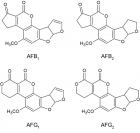
Figure 1
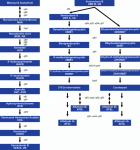
Figure 2

Figure 3
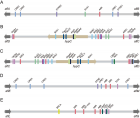
Figure 4
Similar Articles
-
Impact of Calcium Phosphate Nanoparticles on Rice PlantHrishikesh Upadhyaya*,Lutfa Begum,Bishal Dey,P K Nath,S K Panda. Impact of Calcium Phosphate Nanoparticles on Rice Plant. . 2017 doi: 10.29328/journal.jpsp.1001001; 1: 001-010
-
HBV: Genomic Structure, HBVsAg Isolation and innovative Virotherapy Initiation in the Middle EastAboul-Ata E Aboul-Ata*,Essam M Janahi,I M El-Kalamawy,Kathleen Hefferon,Amal Mahmoud. HBV: Genomic Structure, HBVsAg Isolation and innovative Virotherapy Initiation in the Middle East . . 2017 doi: 10.29328/journal.jpsp.1001007; 1: 059-061
-
Advances in research of the structural gene characteristics of the aflatoxin biosynthetic gene clusterZhu-Mei He*,Qi-Zhang Li. Advances in research of the structural gene characteristics of the aflatoxin biosynthetic gene cluster. . 2018 doi: 10.29328/journal.jpsp.1001022; 2: 068-082
-
Causal agents of Post-harvest Rot of Pumpkin (Cucurbita pepo L.) and their control using Indigenous Practices in Hong, Adamawa StateAnjili SM*,Kazi N,Chimbekujwo IB. Causal agents of Post-harvest Rot of Pumpkin (Cucurbita pepo L.) and their control using Indigenous Practices in Hong, Adamawa State. . 2019 doi: 10.29328/journal.jpsp.1001033; 3: 062-066
-
Phytochemical Compounds and the Antifungal Activity of Centaurium pulchellum Ethanol Extracts in IraqNoor Jawad Khadhum, Neepal Imtair Al-Garaawi*, Antethar Jabbar Al-Edani. Phytochemical Compounds and the Antifungal Activity of Centaurium pulchellum Ethanol Extracts in Iraq. . 2024 doi: 10.29328/journal.jpsp.1001137; 8: 079-083
Recently Viewed
-
Hypochlorous acid has emerged as a potential alternative to conventional antibiotics due to its broad-spectrum antimicrobial activityMaher M Akl*. Hypochlorous acid has emerged as a potential alternative to conventional antibiotics due to its broad-spectrum antimicrobial activity. Int J Clin Microbiol Biochem Technol. 2023: doi: 10.29328/journal.ijcmbt.1001026; 6: 001-004
-
KYAMOS Software - Mini Review on the Computer-Aided Engineering IndustryAntonis Papadakis*,Sofia Nikolaidou. KYAMOS Software - Mini Review on the Computer-Aided Engineering Industry. Int J Phys Res Appl. 2025: doi: 10.29328/journal.ijpra.1001105; 8: 010-012
-
Ischemic Stroke and Myocarditis Revealing Behçet’s Disease in a Young Adult: Diagnostic Challenges and Therapeutic PerspectivesObeidat Saleh Muhammed*,Abdallani B,Amine Z,Boucetta A,Bouziane M,Haboub M,Habbal R. Ischemic Stroke and Myocarditis Revealing Behçet’s Disease in a Young Adult: Diagnostic Challenges and Therapeutic Perspectives. J Cardiol Cardiovasc Med. 2025: doi: 10.29328/journal.jccm.1001205; 10: 016-021
-
Evolution of the Mineralocorticoid Receptor and Gender Difference in Cardiovascular PathologyAlessandro Zuccalà*. Evolution of the Mineralocorticoid Receptor and Gender Difference in Cardiovascular Pathology. J Cardiol Cardiovasc Med. 2025: doi: 10.29328/journal.jccm.1001204; 10: 008-015
-
Texture of Thin Films of Aluminum Nitride Produced by Magnetron SputteringStrunin Vladimir Ivanovich,Baranova Larisa Vasilievna*,Baisova Bibigul Tulegenovna. Texture of Thin Films of Aluminum Nitride Produced by Magnetron Sputtering. Int J Phys Res Appl. 2025: doi: 10.29328/journal.ijpra.1001106; 8: 013-016
Most Viewed
-
Evaluation of Biostimulants Based on Recovered Protein Hydrolysates from Animal By-products as Plant Growth EnhancersH Pérez-Aguilar*, M Lacruz-Asaro, F Arán-Ais. Evaluation of Biostimulants Based on Recovered Protein Hydrolysates from Animal By-products as Plant Growth Enhancers. J Plant Sci Phytopathol. 2023 doi: 10.29328/journal.jpsp.1001104; 7: 042-047
-
Sinonasal Myxoma Extending into the Orbit in a 4-Year Old: A Case PresentationJulian A Purrinos*, Ramzi Younis. Sinonasal Myxoma Extending into the Orbit in a 4-Year Old: A Case Presentation. Arch Case Rep. 2024 doi: 10.29328/journal.acr.1001099; 8: 075-077
-
Feasibility study of magnetic sensing for detecting single-neuron action potentialsDenis Tonini,Kai Wu,Renata Saha,Jian-Ping Wang*. Feasibility study of magnetic sensing for detecting single-neuron action potentials. Ann Biomed Sci Eng. 2022 doi: 10.29328/journal.abse.1001018; 6: 019-029
-
Pediatric Dysgerminoma: Unveiling a Rare Ovarian TumorFaten Limaiem*, Khalil Saffar, Ahmed Halouani. Pediatric Dysgerminoma: Unveiling a Rare Ovarian Tumor. Arch Case Rep. 2024 doi: 10.29328/journal.acr.1001087; 8: 010-013
-
Physical activity can change the physiological and psychological circumstances during COVID-19 pandemic: A narrative reviewKhashayar Maroufi*. Physical activity can change the physiological and psychological circumstances during COVID-19 pandemic: A narrative review. J Sports Med Ther. 2021 doi: 10.29328/journal.jsmt.1001051; 6: 001-007

HSPI: We're glad you're here. Please click "create a new Query" if you are a new visitor to our website and need further information from us.
If you are already a member of our network and need to keep track of any developments regarding a question you have already submitted, click "take me to my Query."






